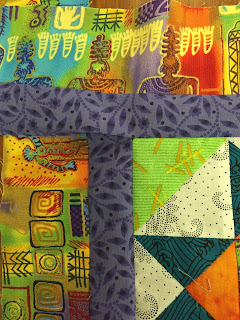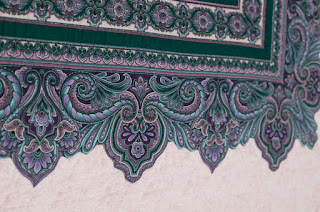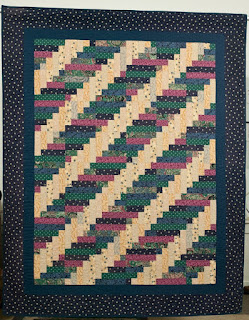I've been asked how to add a mitered border to a quilt.
What is a miter? It is a 45 degree angle seam, making the border fabric appear as a picture frame does on a picture:
 |
| Two fabrics--an inner tan solid and a border stripe |
 |
| Two fabrics--an inner black solid and a batik print |
 |
Two fabrics--a narrow inner rose and a border stripe
|
Here is a single fabric mitered, the green stripe, and is an example of what NOT to do--the narrow white solid was first added as a regular "butted" border, then the green stripe was mitered. If you are looking for "rules", it is considered better design to treat both outside borders in the same manner:
In looking through my own quilts, it became apparent to me that I used to miter many of my borders and today I rarely do. This is true of the many quilts I see friends, guild members and students make--miters are rare. In fact, 20 years ago I used to include how to add a mitered border in my beginning class--today I do not.
Why is this? Most quilters think it is "hard" to add a miter--it doesn't have to be. It certainly uses more fabric and that is a factor when I am "shopping" in my closet and only have a certain amount of fabric. And border stripe fabrics look wonderful when mitered--we have a lot fewer of those today than 20-30 years ago and quilters don't know how to use them. An excellent reference on working with border prints comes from the master of these fabrics:
Jinny Beyer.
Let's look at the basics of adding a mitered border to your quilt. Here is a small sample--of course, the same information applies to a bed-size quilt. These blocks are 6" finished and the purple sashing is 1" finished--right now, this quilt is 13" x 13" finished:
Here is the quilt with the double borders laid out:
With butted borders, I would cut two purple borders 13.5" x 1.5" for the left and right sides. After adding them, I would cut two more 15.5" x 1.5" for the top and bottom. Then I would do the same with the outer border--each would be cut to exact size then added to the quilt, one at a time. This helps make certain your quilt remains square.
With mitered borders, I make "border fabric". This means I will sew the narrow purple fabric to the print fabric BEFORE sewing them onto the quilt. This is one of the reasons I like to miter borders on a bed quilt. If I had 10" of border, made up of three different fabrics, it would take handling the entire quilt under the needle 12 times to add each of those borders separately if I did the "butted" borders method. By doing the "mitered" method, I only have the entire quilt under the needle 4 times, as I add each of the four borders that have been created as "border fabric".
Here is the trick--you have to know how long to cut those strips. There are two options to consider.
FIRST OPTION: cut each of the fabrics you want for your border the same length, the finished outside measurement of the quilt plus about 1" for insurance. This takes the most fabric but eliminates doing the math for each border. In the same quilt above I would cut both the purple and the print 20" NOTE:The print fabric was cut 2.25" wide because I had 4.5" strips leftover and it was easy to cut those in half. The math:
6" + 1" + 6" = 13" center of the quilt
1" + 1" = 2" purple inner borders
1.75" + 1.75" = 3.5" print outer borders
1" minimum extra = 1"
Total length for each border = 19.5"--let's just cut them 20" to keep it simple
NOTE--if your quilt is a rectangle, you will calculate the sides separately from the top and bottom. Another reason I like square quilts and often make them.
SECOND OPTION: cut the inner borders the finished length plus 1" for insurance. Do the same with the outer borders. Fold each in half, mark the middle, pin in the middle so you are staggering the inner border on the outer border. This saves some of the inner fabric--especially if the outer border is really a lot wider than the inner one. In this little sample it really doesn't matter as it doesn't save much. The math:
Purple fabric:
6" + 1" + 6" = 13" center of the quilt
1" + 1" = 2" purple inner borders
1" minimum extra = 1"
Total length for purple inner border = 16"--cut four of these, saving 4" on each one
Outer Print fabric:
6" + 1" + 6" + 1" + 1" = 15" center of quilt and width of both finished purple borders
1.75" + 1.75" = 3.5" finished width of both outer borders
1" minimum extra = 1"
Total length for outer print border = 19.5--again, I will just cut them 20", cut four of these.
The photo above shows both of these methods. On the top is the FIRST option, each was cut 20" and then joined to create "border fabric". On the bottom is the SECOND option, purple borders are cut shorter than the outer borders, then centered on the outer border fabric and sewn. In both cases, I pressed the seam toward the purple--it is narrower and might not have any quilting in it. It is also darker but the overriding thought process is about the quilting--where will the thickness of the seam allowances be less of a bother?
Now that the border fabric is created, it's time to sew them to the quilt. Find the center by pressing the border fabric in half, make a pencil mark at the center. Now make another mark 6.5" on either side of that center mark. This is half of the center of the quilt (13") and gives you the exact place to start and stop sewing, 1/4" in from the outer edges of the quilt.
On a long border, I make pencil marks at several places where the border should line up with the body of the quilt, like where blocks join the border. If you just sew a long border to the quilt without measuring, the chances are very good your border will be wavy or full or short, not nice and flat as you want it to be.
Pin the border to the center to the quilt, matching the marks and you are ready to sew, one border at a time. You may also find it helps to make a mark on the four corners of the quilt, 1/4" in from the outer edge--this is the starting and stopping point. I sew with the quilt center on top so I can keep an eye of those seam allowances and prevent them from flipping in the wrong direction:
Here is the first border sewn in place. This is one of those rare places in piecing a quilt where you backstitch because this seam will not be crossed by another seam to lock it:
 |
| The starting edge |
 |
| The stopping edge |
Press toward the purple inner border, the path of least resistance:
Pin and sew the second border on in the same manner, being sure to start and stop at the dot, 1/4" inside the outer edge. If you go a "stitch too far", just take that stitch out:
Turn to the back side. Place the borders on top of each other, folding the quilt center at a 45 degree angle. Be careful to align the seams of the purple/print borders exactly on top of each other. When I have a border stripe fabric, I carefully check by pinning that the stripes are aligned well:
Use a ruler and pencil to draw the sewing line. If you have a Half Square Triangle ruler, use it. Align the sewn seam on the border with a line on the ruler to keep things straight and square:
If you have a square ruler, you can use it, again being sure the border fabrics are straight:
When I have multiple borders or a border stripe fabric, I usually baste the important intersections before I sew the seam for real. Here I have basted only the place where the purple and print meet, with very long stitches:
It only takes a few seconds to do this, and if things don't match up as well as you would like, it's easy to remove the basting stitches, fiddle with it again, and re-baste. When you are happy, turn the stitch length back to normal size and sew the seam, directly on top of those basting stitches. Be sure to start at the dot where the quilt joins the border and backstitch. I backstitch at the outer edge as well. If the whole seam is good, I remove the basting stitches:
To trim the excess fabric away, place a ruler on the sewn seam, 1/4" away from the seam--remember, the part you want to PROTECT is under the ruler:
Trim the excess away and press the seam open:
 |
| The back |
 |
| The front |
Continue until you have added all four borders to the quilt and sewn each miter. I tell students the first time you do this you will have one that is perfect, one that is awful and two that are pretty good. The next time you do it, none will be awful. The third time you do it, you will have the process down pat.
A mitered border can add a touch of elegance to your quilt and it looks like you took a bit of extra care to make the quilt special. Try it, you just might like it!
Let's quilt.
Barbara































































